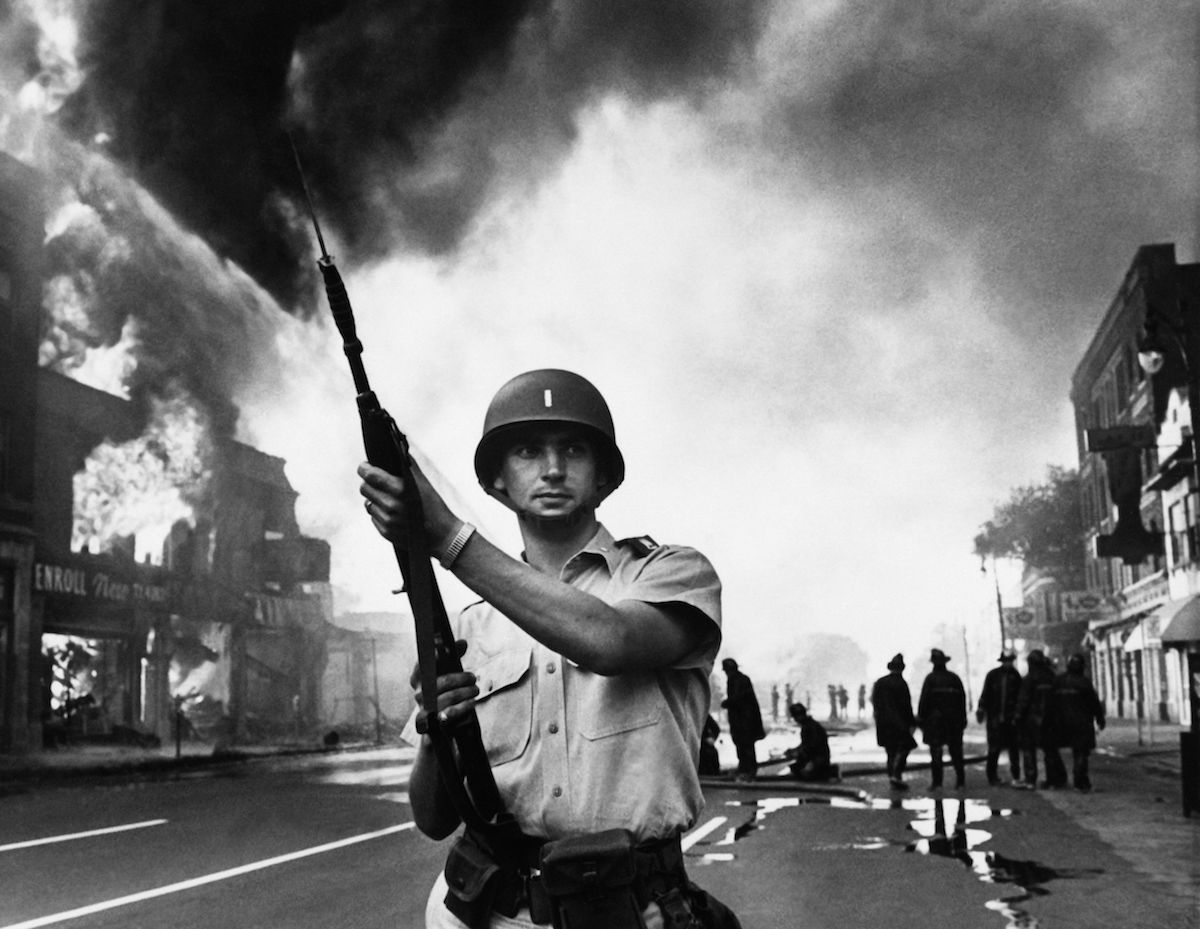
For some Americans, the summer of 1967 was the “Summer of Love.” To others, it was just the opposite: a “long, hot summer,” characterized by more than 150 separate riots responding to racial injustice in American cities.
The season arguably peaked when federal paratroopers were called in to put an end to the five days of looting and arson in Detroit, which started in the middle of the night precisely 50 years ago this coming Sunday, after police raided a popular but unlicensed African-American watering hole on Detroit’s 12th Street on July 23, 1967. “At week’s end, there were 41 known dead, 347 injured, 3,800 arrested. Some 5,000 people were homeless (the vast majority Negro), while 1,300 buildings had been reduced to mounds of ashes and bricks and 2,700 businesses sacked,” according to TIME’s cover story on the events.
Wally Terry of TIME’s Washington bureau, who had been sent to the Motor City shortly after returning from Vietnam, said that he felt “more danger in Detroit than I ever was over there” — and artist Robert Templeton, who would create TIME’s cover, was the target of thrown bricks as he drove around the city “using the steering wheel as an easel.” Detroit Mayor Jerome Cavanagh likened the city to Berlin in 1945.
“We have endured a week such as no nation should live through: a time of violence and tragedy,” President Lyndon B. Johnson declared in a special address to the nation. And the media agreed: America was facing “a national crisis,” the editorial leading off LIFE magazine‘s cover feature on the riot declared.
But, behind the scenes, the national political calculations about the riot were complicated. President Johnson and Michigan Governor George Romney clashed over when and where to send federal troops to back up the relatively inexperienced Michigan National Guardsmen, who would later be held at least partly to blame for how the crisis escalation.
TIME speculated that the reason for the disagreement had perhaps less to do with Detroit and more to do with the upcoming presidential election:
From the outset, the race crisis crackled with electoral electricity. The Detroit riot brought the first confrontation between Lyndon Johnson and Michigan’s Governor George Romney, who, despite some slippage in recent months, is still a formidable possibility for the next Republican presidential nomination. Both men were sensitive to the big—and unpredictable—implications for 1968 in everything they did.
Aware that the combined efforts of the Detroit police and Michigan’s National Guard would probably not be enough to contain Detroit’s rioters, Romney telephoned Attorney General Ramsey Clark at 3:30 a.m. Monday to let him know that he might have to ask for reinforcements in the form of federal troops. The President, who had been alerted before midnight by Clark that things might fall apart, dispatched Cyrus Vance, the recently retired Deputy Defense Secretary and a longtime friend, to size up the situation in Detroit.
By 10 a.m., Romney and Detroit’s Mayor Jerome Cavanagh were convinced that they would need Army aid: a wire went off to the White House saying that there was “reasonable doubt” that the situation could be contained. The President turned to Defense Secretary Robert McNamara and, at 11:02 a.m., ordered up the paratroops—but sent them only as far as Selfridge Air Force Base outside Detroit, not into the riot area itself.
Simultaneously, the Republican Coordinating Committee rushed into the act. Twenty-six members of the 36-man policymaking panel had been at work on a riot paper, drafted by two-time G.O.P. Presidential Candidate Thomas E. Dewey, Florida Representative William Cramer (author of the House-passed antiriot bill) and Colorado Governor John Love. Accusing Lyndon Johnson of a good share of responsibility for the state of anarchy that prevailed in the nation’s riot-torn cities, it also hinted that a conspiracy was behind the disorder.
Meanwhile, Detroit deteriorated. Romney, anxious to move the waiting paratroopers into the city, told Cy Vance: “We gotta move, man, we gotta move.” Finally, at midnight, the President went on national television to explain the state of emergency and the ordering of troops into Detroit. He also made no fewer than seven references to Romney‘s inability to control his own state.
While LBJ (who would not end up running in ’68) said he believed that the only response to the uprising could be “an attack — mounted at every level — upon the conditions that breed despair and violence,” one fact that made the riot baffling was that Detroit’s anti-poverty measures were hailed as a model for cities nationwide; all in all, nearly $30 million was being poured into Head Start, recreation, family-planning programs, and job programs. Detroit didn’t even make the Congress of Racial Equality’s list of 12 cities “where racial trouble was likely to flare up,” TIME reported.
But, as African-American comedian Dick Gregory put it at a national conference of Black Power leaders in Newark right before the Detroit riots, “How in the hell are you going to make a list of 400 years of them misusing you?”
Fifty years later, the Kathryn Bigelow’s new movie Detroit will zero in on a different aspect of those tumultuous five days: the death that took place at the Algiers Motel in an ambush led by Guardsmen who heard snipers were hiding out there. The film is due to be released Aug. 4.
More Must-Reads from TIME
- Cybersecurity Experts Are Sounding the Alarm on DOGE
- Meet the 2025 Women of the Year
- The Harsh Truth About Disability Inclusion
- Why Do More Young Adults Have Cancer?
- Colman Domingo Leads With Radical Love
- How to Get Better at Doing Things Alone
- Michelle Zauner Stares Down the Darkness
Write to Olivia B. Waxman at olivia.waxman@time.com